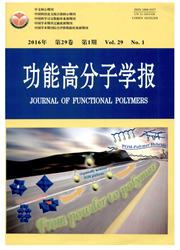

 中文摘要:
中文摘要:
以生物大分子γ-聚谷氨酸(γ-PGA)、β-环糊精(β-CD)为反应单元,通过酯化反应,制备接枝共聚物(γ-PGA-g-β-CD),用氢核磁共振(1 H-NMR)对共聚物进行结构表征。接着将γ-PGAg-β-CD在选择性溶剂中进行自组装,形成自组装胶束纳米粒子,利用纳米粒度分析仪及原子力显微镜(AFM)对胶束粒子的粒径和形貌进行表征。最后以γ-PGA-g-β-CD自组装胶束粒子溶液为电解液,结合恒电位电沉积技术,在镁合金表面制备γ-PGA-g-β-CD生物纳米涂层材料,利用傅里叶变换红外光谱(FT-IR)、扫描电子显微镜(SEM)及电化学工作站分别对涂层的化学组分、表面形貌以及电化学腐蚀性能进行表征。研究结果显示:β-CD的接枝率为28%,γ-PGA-g-β-CD自组装胶束粒子的流体动力学直径为(168±5.3)nm,所制备的γ-PGA-g-β-CD生物涂层可降低镁合金的腐蚀速率,具有较好的防护作用。
 英文摘要:
英文摘要:
Amphiphilic r-polyglutamic acid-g-β-cyelodextrin (γ-PGA-g-β-CD) copolymer was synthesized by esterification reaction between γ-polygluta-mic acid (γ-PGA) and β-eyclodextrin (β-CD). Its structure was characterized by Nuclear Magnetic Resonance Spectrometer (1H-NMR). The copolymer could self- assemble into colloidal particles and the particles were studied by Nanometer Particle Size Analyzer, and Atom Force Microscope (AFM). Then, the γ-PGA-g-β-CD colloidal particle solution was used as electrolyte. Combining with electrodeposition technique, nanostructured coating was prepared on the surface of magne- sium alloy. The composition, morphology, and corrosion resistance of the coating were monitored using Fourier Transform Infrared Spectroscopy (FT-IR), Scanning Electron Microscopy (SEM), and corrosion test. Results show that the grafting degree of β-CD is 28 %, and the diameter of )γ-PGA-g-β-CD colloidal particles is (168±5.3) nm. The corrosion rate of magnesium alloy with γ-PGA-g-β-CD biological coating is reduced. The coating has a good protective effect.
 同期刊论文项目
同期刊论文项目
 同项目期刊论文
同项目期刊论文
 Layer-by-layer self-assembled hybrid multilayer films based on poly(sodium 4-styrenesulfonate) stabi
Layer-by-layer self-assembled hybrid multilayer films based on poly(sodium 4-styrenesulfonate) stabi Preparation of superhydrophobic antistatic coatings from branched alternating copolymers P(St-alt-MA
Preparation of superhydrophobic antistatic coatings from branched alternating copolymers P(St-alt-MA Preparation of photo-sensitive poly(gamma-glutamic acid) nanoparticles and application for immobiliz
Preparation of photo-sensitive poly(gamma-glutamic acid) nanoparticles and application for immobiliz One-pot green synthesis of nanohybrid structures: gold nanoparticles in poly(γ -glutamic acid) copol
One-pot green synthesis of nanohybrid structures: gold nanoparticles in poly(γ -glutamic acid) copol Fabrication of graphene/polyaniline composite multilayer films by electrostatic layer-by-layer assem
Fabrication of graphene/polyaniline composite multilayer films by electrostatic layer-by-layer assem One-pot synthesis of a graphene oxide coated with an imprinted sol-gel for use in electrochemical se
One-pot synthesis of a graphene oxide coated with an imprinted sol-gel for use in electrochemical se Synthesis of water dispersible polyaniline/poly(styrenesulfonic acid) modified graphene composite an
Synthesis of water dispersible polyaniline/poly(styrenesulfonic acid) modified graphene composite an Design and synthesis of water-soluble photosensitive -cyclodextrin and its application in dispersing
Design and synthesis of water-soluble photosensitive -cyclodextrin and its application in dispersing A Novel Chemosensor Based on Rhodamine Derivative for Colorimetric and Fluorometric Detection of Cu2
A Novel Chemosensor Based on Rhodamine Derivative for Colorimetric and Fluorometric Detection of Cu2 Micelles formation of polystyrene-co-poly (N-acryloylthymine) and its aggregation behavior induced b
Micelles formation of polystyrene-co-poly (N-acryloylthymine) and its aggregation behavior induced b Photoresponsive Water-Dispersible Polyaniline Nanoparticles Through Template Synthesis with Copolyme
Photoresponsive Water-Dispersible Polyaniline Nanoparticles Through Template Synthesis with Copolyme Synthesis of Stable Aqueous Dispersion of Graphene/Polyaniline Composite Mediated by Polystyrene Sul
Synthesis of Stable Aqueous Dispersion of Graphene/Polyaniline Composite Mediated by Polystyrene Sul Facile one-step electrochemical fabrication of a non-enzymatic glucose-selective glassy carbon elect
Facile one-step electrochemical fabrication of a non-enzymatic glucose-selective glassy carbon elect Layer-by-layer assembled ionic-liquid functionalized graphene-polyaniline nanocomposite with enhance
Layer-by-layer assembled ionic-liquid functionalized graphene-polyaniline nanocomposite with enhance Synthesis of an amphiphilic copolymer bearing rhodamine moieties and its self-assembly into micelles
Synthesis of an amphiphilic copolymer bearing rhodamine moieties and its self-assembly into micelles Pickering emulsions stabilized by self-assembled colloidal particles of copolymers of P(St-alt-MAn)-
Pickering emulsions stabilized by self-assembled colloidal particles of copolymers of P(St-alt-MAn)- Self-Assembly and Emulsification of Poly{[styrene-alt-maleic acid]-co-[styrene-alt-(N-3,4-dihydroxyp
Self-Assembly and Emulsification of Poly{[styrene-alt-maleic acid]-co-[styrene-alt-(N-3,4-dihydroxyp 期刊信息
期刊信息
